Pathways to 30 × 30: Evidence-Based Lessons from Global Case Studies in Biodiversity Conservation
Abstract
1. Introduction
2. Materials and Methods
2.1. Data
2.2. Methods
2.2.1. Determining the Optimal Grid Resolution
2.2.2. Assessing Current Protection Coverage for Terrestrial, Freshwater, and Marine Endemic Species
2.2.3. Prioritizing New Protected Areas to Close the Conservation Gaps
- The algorithm first counted the number of unprotected species in each grid cell and identified the cell with the highest count as the top priority for protection (Priority 1).
- Species residing in this cell were then set aside, and the process was repeated for the remaining species, identifying the next highest-count grid cell as the Priority 2 candidate.
- This iterative process continued until all species were covered by at least one grid cell. In cases where multiple grid cells had the same maximum species count, the algorithm made a random selection.
2.2.4. Setting Priorities for Protection in Absence of Comprehensive Information on Protected Areas
3. Results
3.1. Estimation of Mean Protected-Area Size and the Corresponding Grid-Cell Resolution
3.2. Variations in Protected Areas and Endemic Species Coverage Across Case-Study Countries
3.3. Selection of Priority Areas
3.4. Brazil and Cameroon: Similar Geography for Unprotected Species with Small Occurrence Ranges Outside Protected Areas
3.5. South Africa and Costa Rica: Contrasting Geographic Dispersion and Taxonomic Representation of Unprotected Species
3.6. Ecuador and Papua New Guinea: Spatial Implications of Full Species Protection
3.7. Philippines and Madagascar: Marine Species Protection
3.8. India and China: Limitations in Protected-Area Information
4. Discussion
5. Conclusions
Supplementary Materials
Author Contributions
Funding
Institutional Review Board Statement
Informed Consent Statement
Data Availability Statement
Acknowledgments
Conflicts of Interest
World Bank Disclaimer
Abbreviations
| DD | decimal degrees |
| EEZ | Exclusive Economic Zone |
| GBIF | Global Biodiversity Information Facility |
| WDPA | World Database of Protected Areas |
References
- Pimm, S.L.; Jenkins, C.N.; Abell, R.; Brooks, T.M.; Gittleman, J.L.; Joppa, L.N.; Raven, P.H.; Roberts, C.M.; Sexton, J.O. The biodiversity of species and their rates of extinction, distribution, and protection. Science 2014, 344, 1246752. [Google Scholar] [CrossRef] [PubMed]
- Chen, H.; Zhang, T.; Costanza, R.; Kubiszewski, I. Review of the approaches for assessing protected areas’ effectiveness. Environ. Impact Assess. Rev. 2023, 98, 106929. [Google Scholar] [CrossRef]
- Pulido-Chadid, K.; Virtanen, E.; Geldmann, J. How effective are protected areas for reducing threats to biodiversity? A systematic review protocol. Environ. Evid. 2023, 12, 18. [Google Scholar] [CrossRef] [PubMed]
- Llorente-Culebras, S.; Ladle, R.J.; Santos, A.M. Publication trends in global biodiversity research on protected areas. Biol. Conserv. 2023, 281, 109988. [Google Scholar] [CrossRef]
- Rodríguez-Rodríguez, D.; Martínez-Vega, J. Effectiveness of Protected Areas in Conserving Biodiversity: A Worldwide Review; Springer: Cham, Switzerland, 2022. [Google Scholar] [CrossRef]
- Ma, B.; Zhang, Y.; Hou, Y.; Wen, Y. Do protected areas matter? A systematic review of the social and ecological impacts of the establishment of protected areas. Int. J. Environ. Res. Public Health 2020, 17, 7259. [Google Scholar] [CrossRef]
- Geldmann, J.; Barnes, M.; Coad, L.; Craigie, I.D.; Hockings, M.; Burgess, N.D. Effectiveness of terrestrial protected areas in reducing habitat loss and population declines. Biol. Conserv. 2013, 161, 230–238. [Google Scholar] [CrossRef]
- Mora, C.; Sale, P.F. Ongoing global biodiversity loss and the need to move beyond protected areas: A review of the technical and practical shortcomings of protected areas on land and sea. Mar. Ecol. Prog. Ser. 2011, 434, 251–266. [Google Scholar] [CrossRef]
- Nelson, A.; Chomitz, K.M. Effectiveness of strict vs. multiple use protected areas in reducing tropical forest fires: A global analysis using matching methods. PLoS ONE 2011, 6, e22722. [Google Scholar] [CrossRef]
- Joppa, L.; Pfaff, A. Reassessing the forest impacts of protection: The challenge of nonrandom location and a corrective method. Ann. N. Y. Acad. Sci. 2010, 1185, 135–149. [Google Scholar] [CrossRef]
- Bruner, A.G.; Gullison, R.E.; Rice, R.E.; Da Fonseca, G.A. Effectiveness of parks in protecting tropical biodiversity. Science 2001, 291, 125–128. [Google Scholar] [CrossRef]
- Dasgupta, S.; Blankespoor, B.; Wheeler, D. Revisiting Global Biodiversity: A Spatial Analysis of Species Occurrence Data from the Global Biodiversity Information Facility; World Bank Group: Washington, DC, USA, 2024; Policy Research Working Paper No. 10821; Available online: http://hdl.handle.net/10986/41788 (accessed on 5 November 2024).
- Protected Planet. 2024. Available online: https://www.protectedplanet.net/en/thematic-areas/wdpa?tab=WDPA (accessed on 3 July 2024).
- World Bank. National level dataset of Species Endemism, Small Occurrence and Species at Risk Data. Available online: https://datacatalog.worldbank.org/search/dataset/0066034/global_biodiversity_data: (accessed on 10 December 2024).
- Flanders Marine Institute. Maritime Boundaries Geodatabase: Maritime Boundaries and Exclusive Economic Zones (200NM); Version 12; Flanders Marine Institute: Oostende, Belgium, 2023. [Google Scholar] [CrossRef]
- Protected Planet. 2024. Available online: https://www.protectedplanet.net/country/IND (accessed on 3 July 2024).
- Protected Planet. 2024. Available online: https://www.protectedplanet.net/country/CHN (accessed on 3 July 2024).
- World Bank. Country Boundaries. 2024. Available online: https://datacatalog.worldbank.org/search/dataset/0038272/World-Bank-Official-Boundaries (accessed on 3 July 2024).
- Intergovernmental Science-Policy Platform on Biodiversity and Ecosystem Services (IPBES). Global Assessment Report on Biodiversity and Ecosystem Services. Available online: https://www.ipbes.net/global-assessment (accessed on 5 October 2024).
- Hoffmann, S. Challenges and opportunities of area-based conservation in reaching biodiversity and sustainability goals. Biodivers. Conserv. 2022, 31, 325–352. [Google Scholar] [CrossRef]
- Maxwell, S.L.; Cazalis, V.; Dudley, N.; Hoffmann, M.; Rodrigues, A.S.; Stolton, S.; Visconti, P.; Woodley, S.; Kingston, N.; Lewis, E.; et al. Area-based conservation in the twenty-first century. Nature 2020, 586, 217–227. [Google Scholar] [CrossRef] [PubMed]
- Delso, Á.; Fajardo, J.; Muñoz, J. Protected area networks do not represent unseen biodiversity. Sci. Rep. 2021, 11, 12275. [Google Scholar] [CrossRef]
- Venter, O.; Magrach, A.; Outram, N.; Klein, C.J.; Possingham, H.P.; Di Marco, M.; Watson, J.E. Bias in protected-area location and its effects on long-term aspirations of biodiversity conventions. Conserv. Biol. 2018, 32, 127–134. [Google Scholar] [CrossRef]
- Zeng, Y.; Senior, R.A.; Crawford, C.L.; Wilcove, D.S. Gaps and weaknesses in the global protected area network for safeguarding at-risk species. Sci. Adv. 2023, 9, eadg0288. [Google Scholar] [CrossRef]
- Pyšek, P.; Richardson, D.M.; Pergl, J.; Jarošík, V.; Sixtová, Z.; Weber, E. Geographical and taxonomic biases in invasion ecology. Trends Ecol. Evol. 2008, 23, 237–244. [Google Scholar] [CrossRef]
- Kraus, D.; Enns, A.; Hebb, A.; Murphy, S.; Drake, D.A.R.; Bennett, B. Prioritizing nationally endemic species for conservation. Conserv. Sci. Pract. 2023, 5, e12845. [Google Scholar] [CrossRef]
- Coelho, N.; Gonçalves, S.; Romano, A. Endemic plant species conservation: Biotechnological approaches. Plants 2020, 9, 345. [Google Scholar] [CrossRef]
- Stuessy, T.F.; Baeza, C.M.; López-Sepúlveda, P.; Rodríguez, R.; Swenson, U.; Crawford, D.J.; Ruiz, E.A. Conservation of native and endemic species. In Plants of Oceanic Islands: Evolution, Biogeography, and Conservation of the Flora of the Juan Fernández (Robinson Crusoe) Archipelago; Cambridge University Press: Cambridge, UK, 2018; pp. 149–161. [Google Scholar]
- Burlakova, L.E.; Karatayev, A.Y.; Karatayev, V.A.; May, M.E.; Bennett, D.L.; Cook, M.J. Endemic species: Contribution to community uniqueness, effect of habitat alteration, and conservation priorities. Biol. Conserv. 2011, 144, 155–165. [Google Scholar] [CrossRef]
- Işik, K. Rare and endemic species: Why are they prone to extinction? Turk. J. Bot. 2011, 35, 411–417. [Google Scholar] [CrossRef]
- Olson, D.M.; Dinerstein, E.; Wikramanayake, E.D.; Burgess, N.D.; Powell, G.V.N.; Underwood, E.C.; D’amico, J.A.; Itoua, I.; Strand, H.E.; Morrison, J.C.; et al. Terrestrial Ecoregions of the World: A New Map of Life on Earth: A new global map of terrestrial ecoregions provides an innovative tool for conserving biodiversity. BioScience 2001, 51, 933–938. [Google Scholar] [CrossRef]
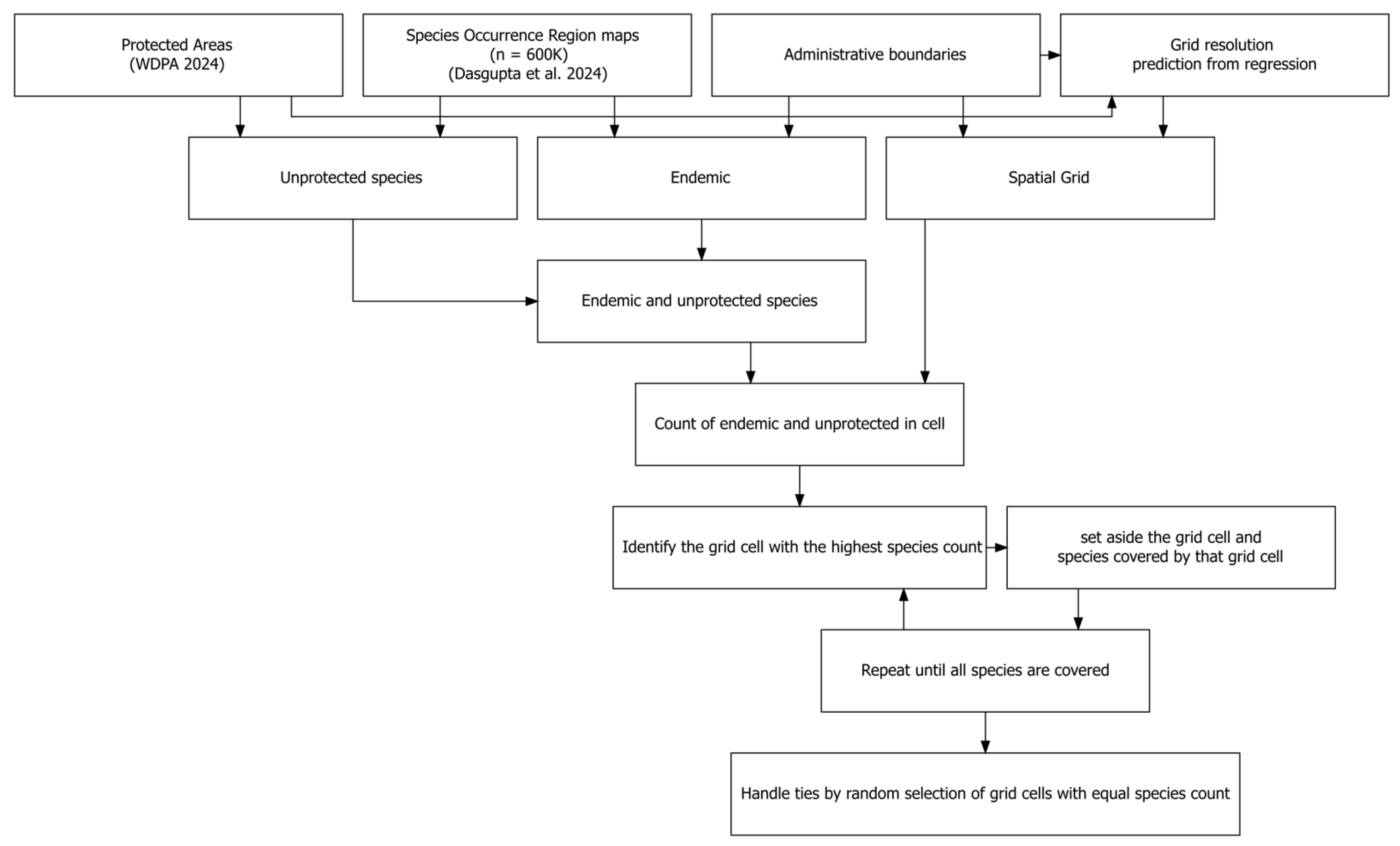
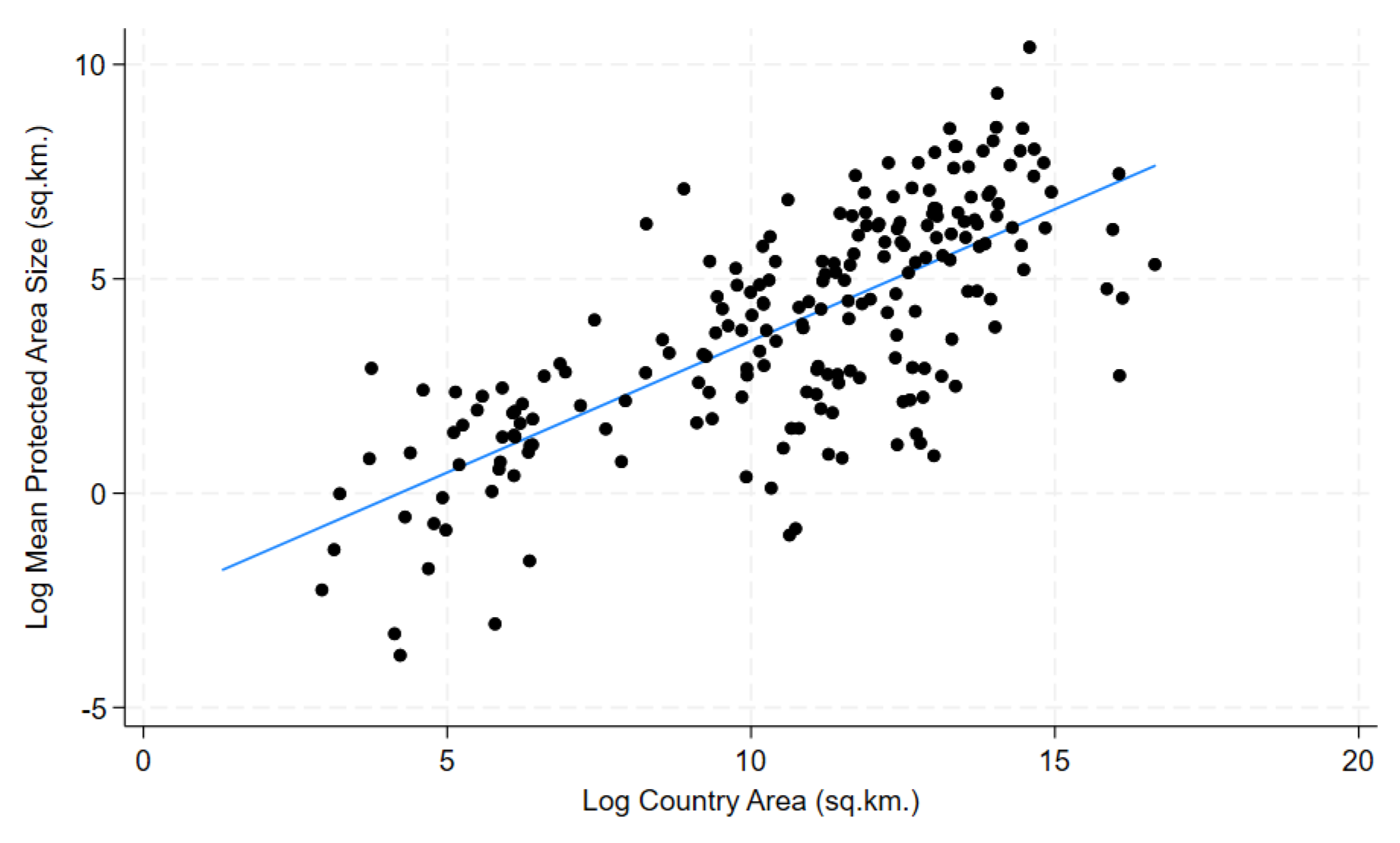
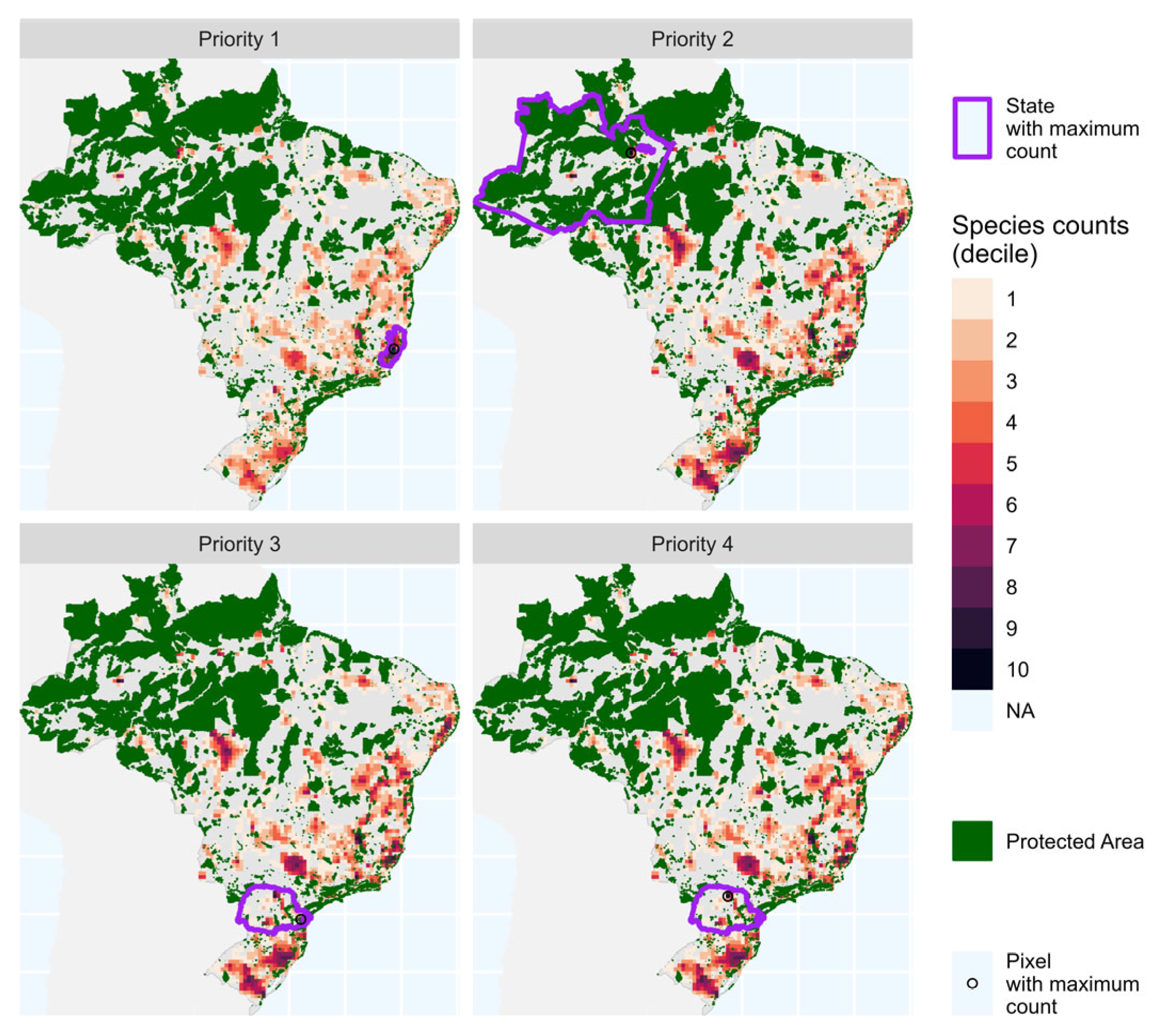
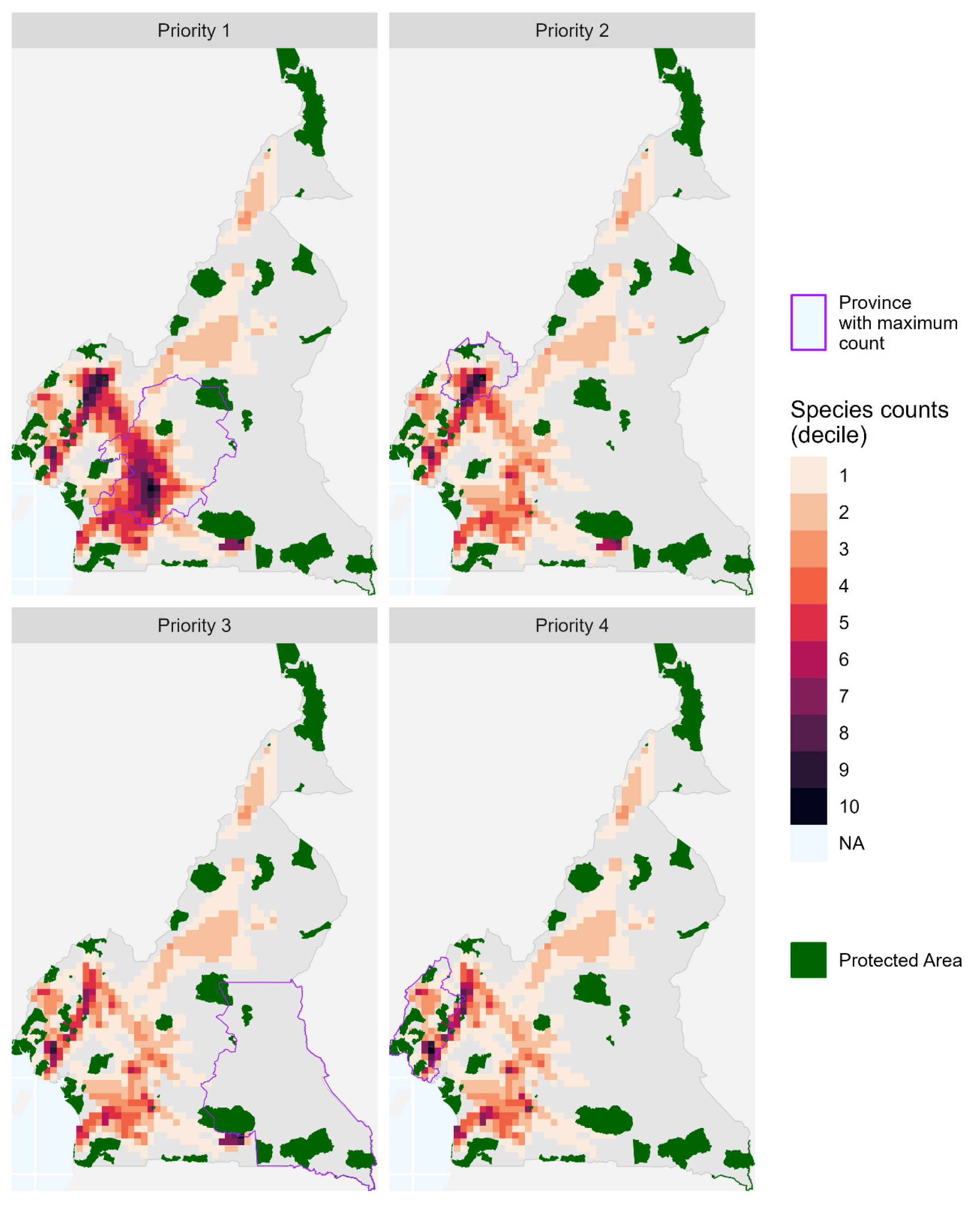
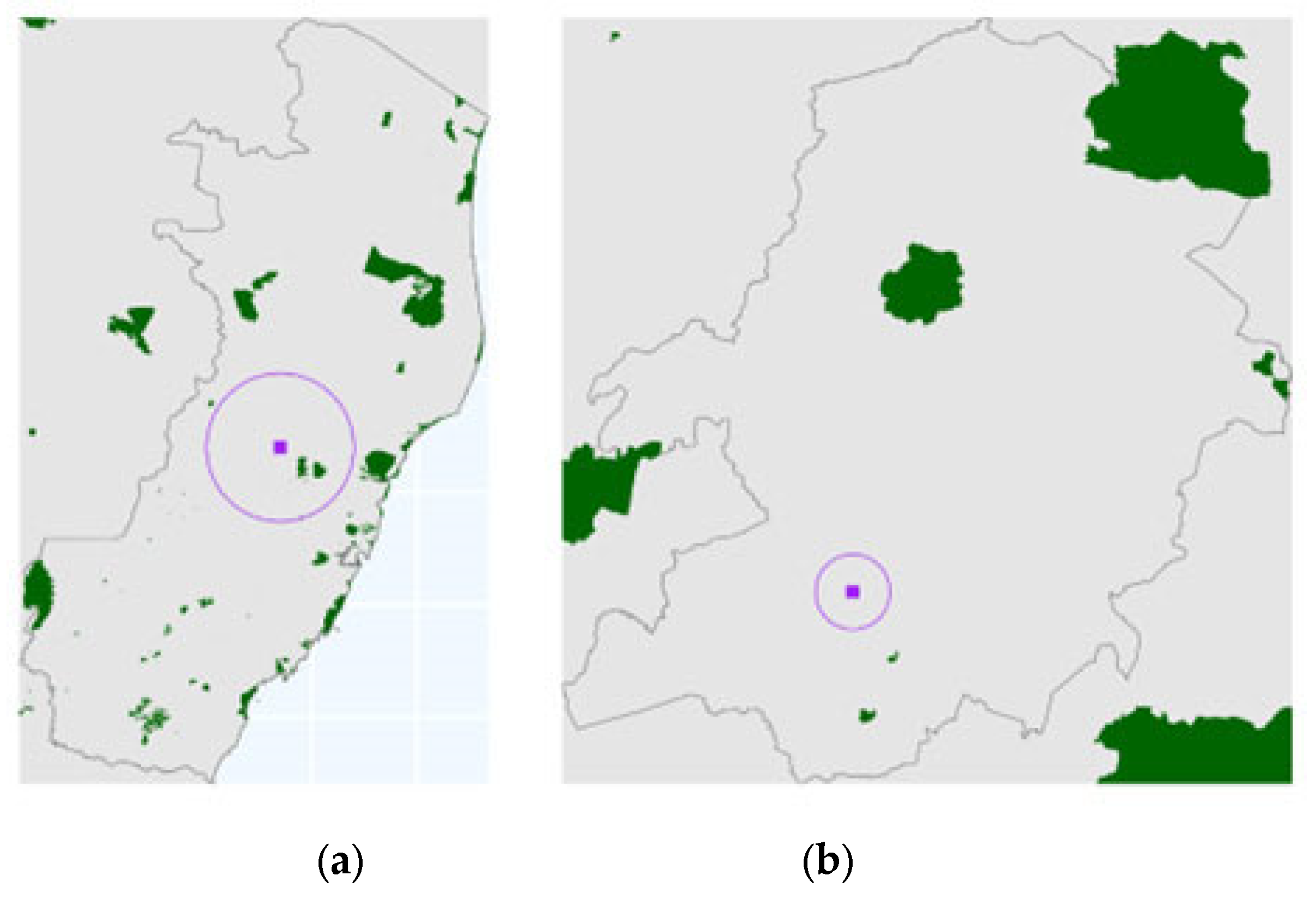
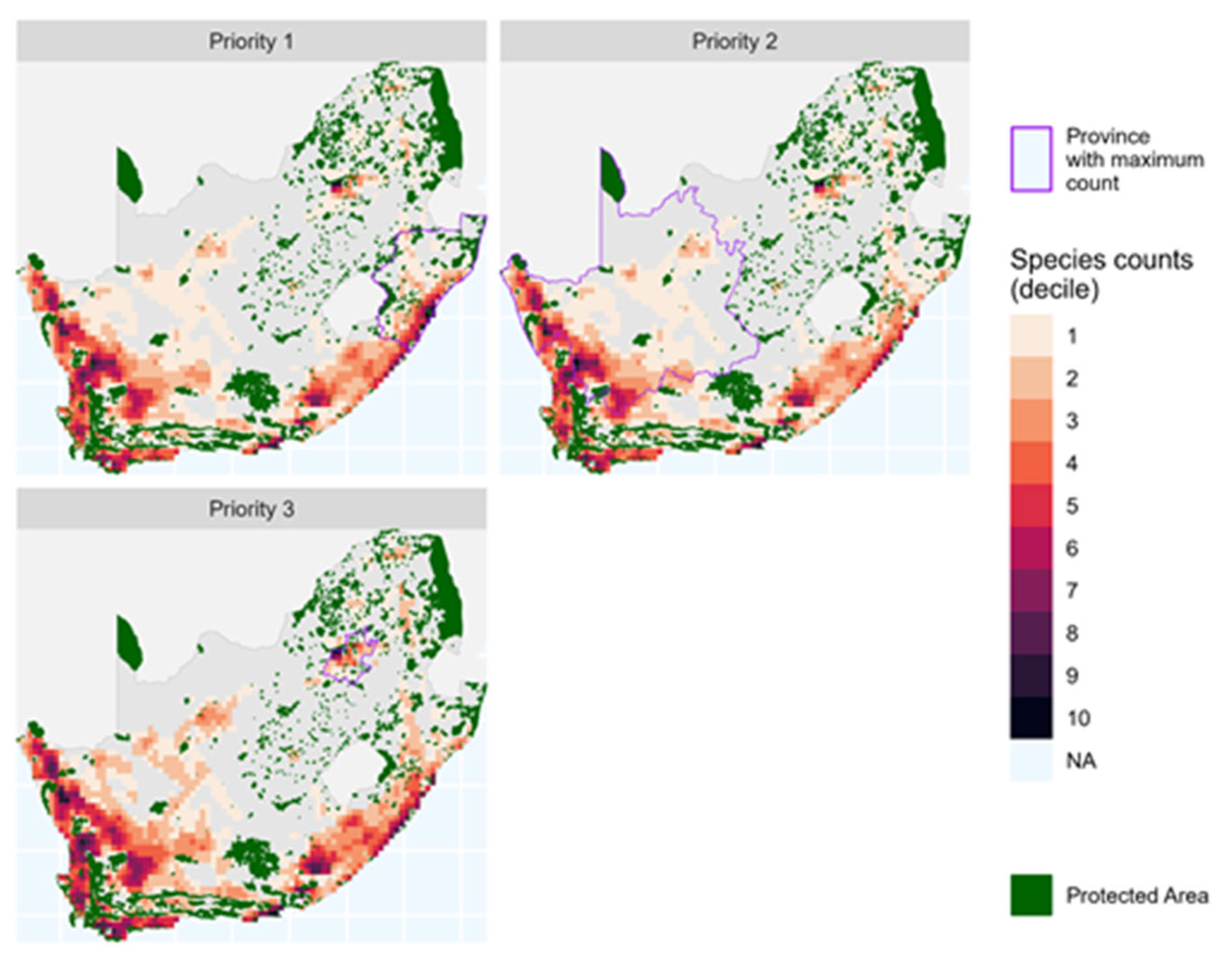
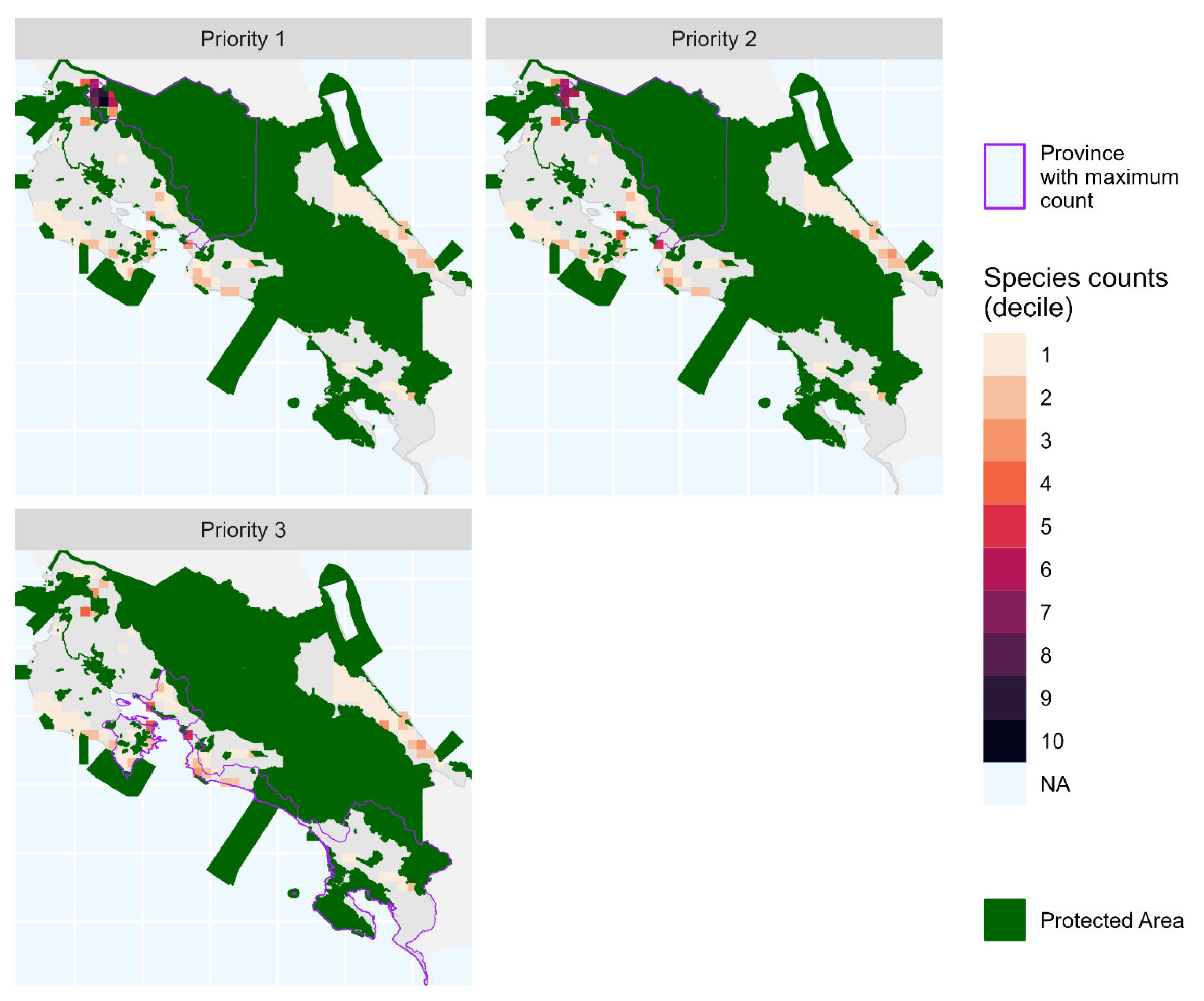
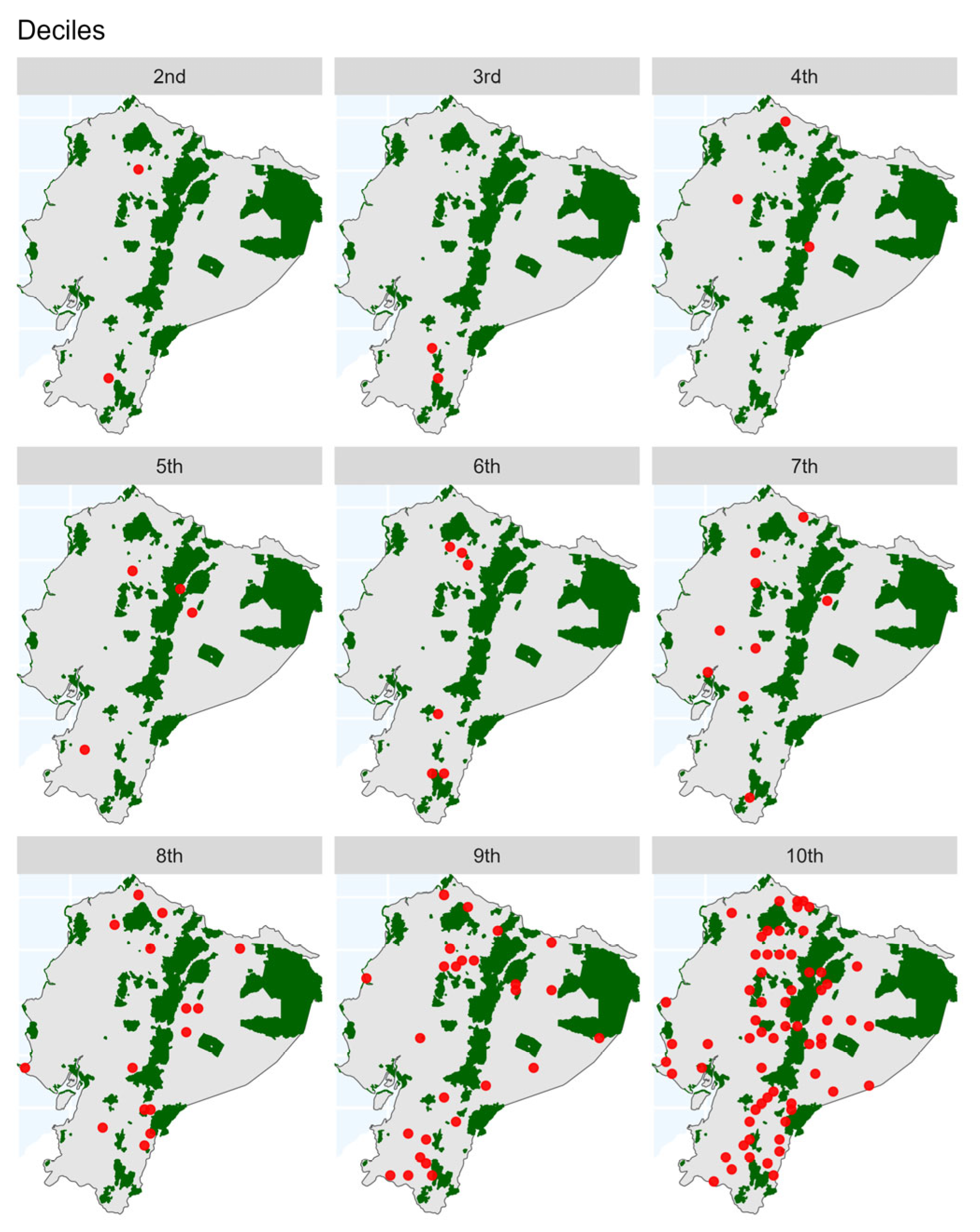
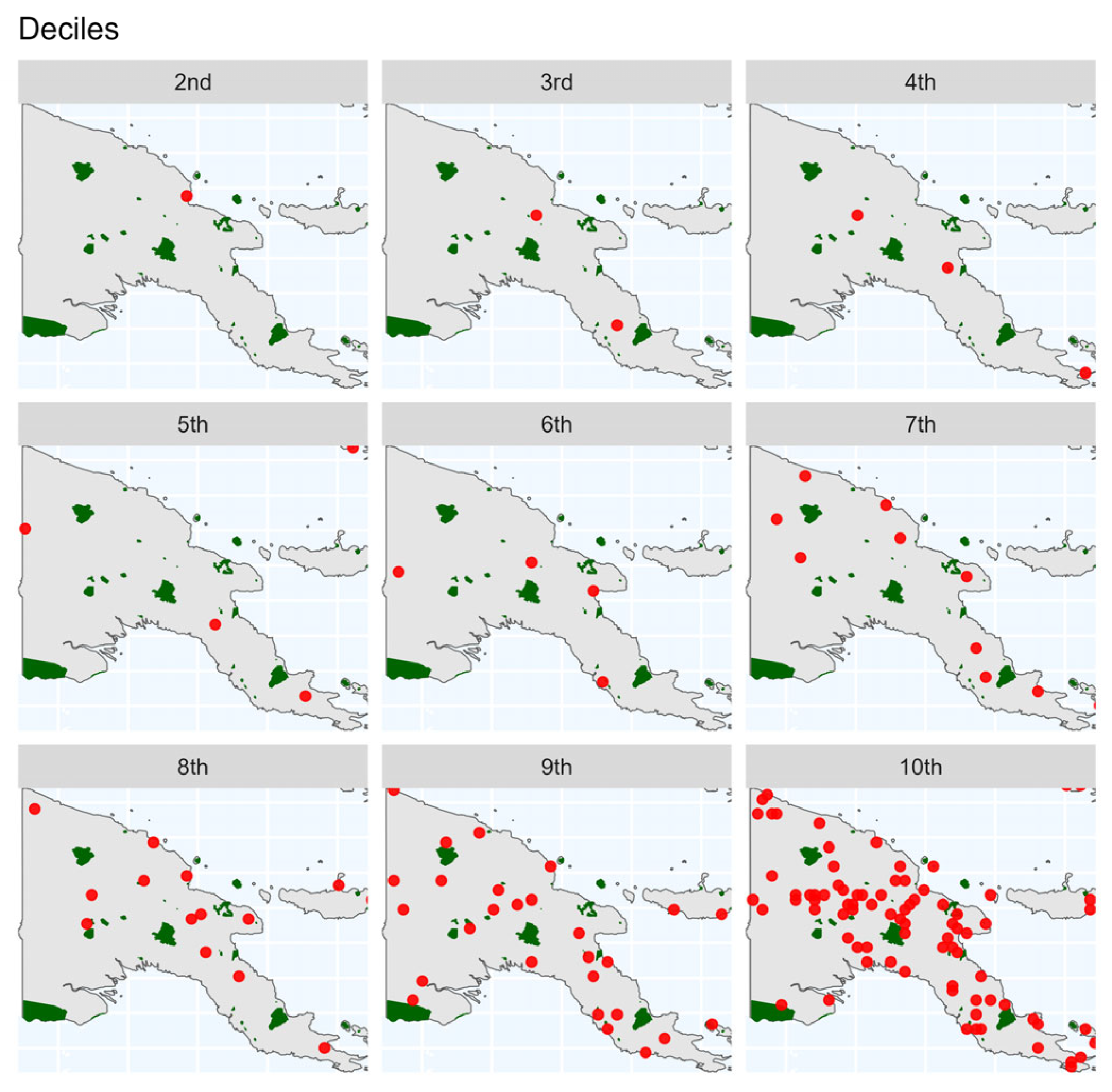
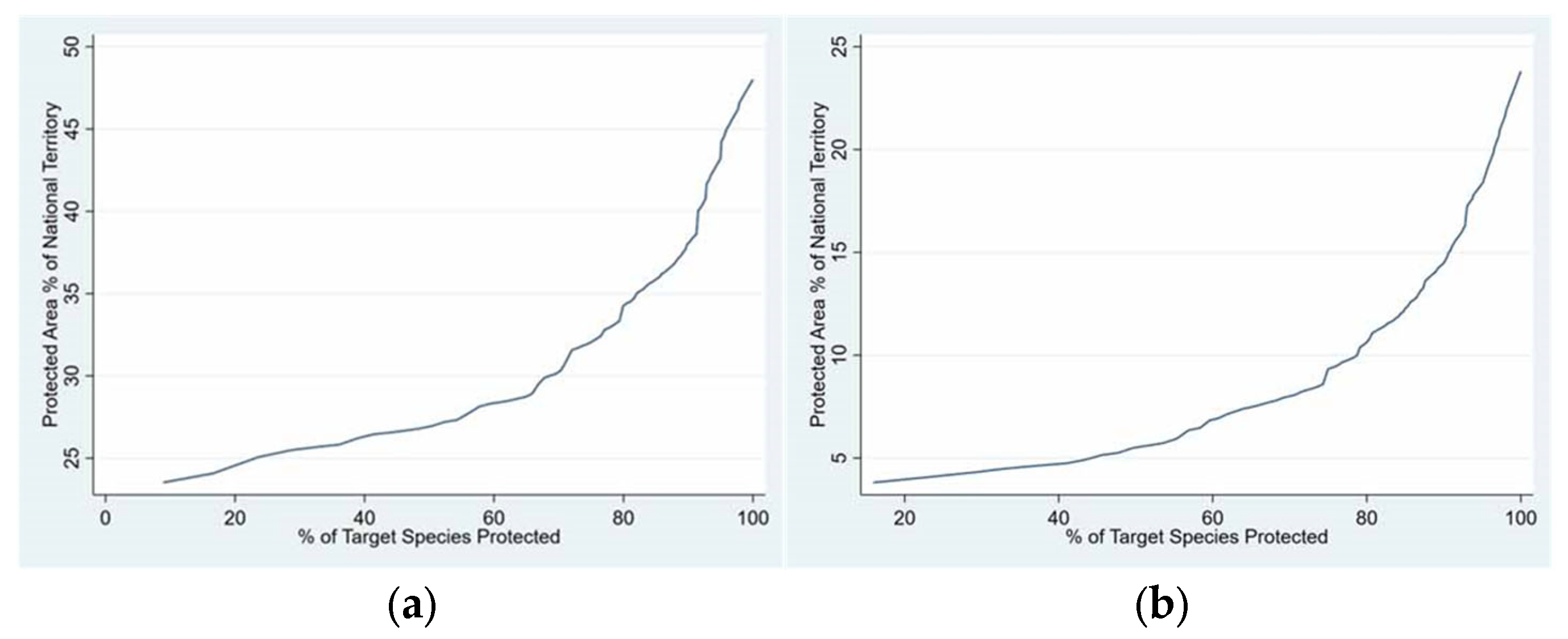
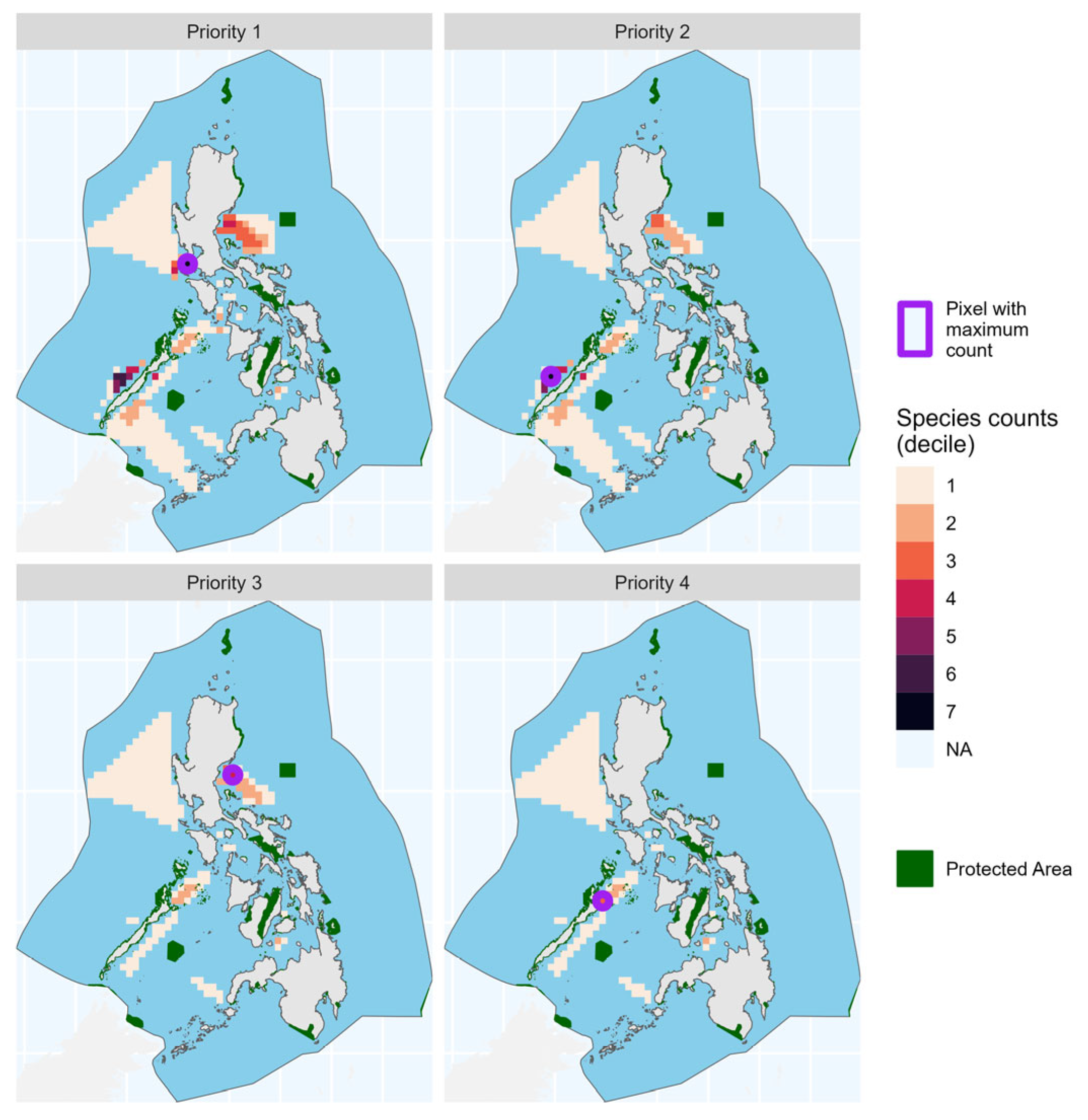

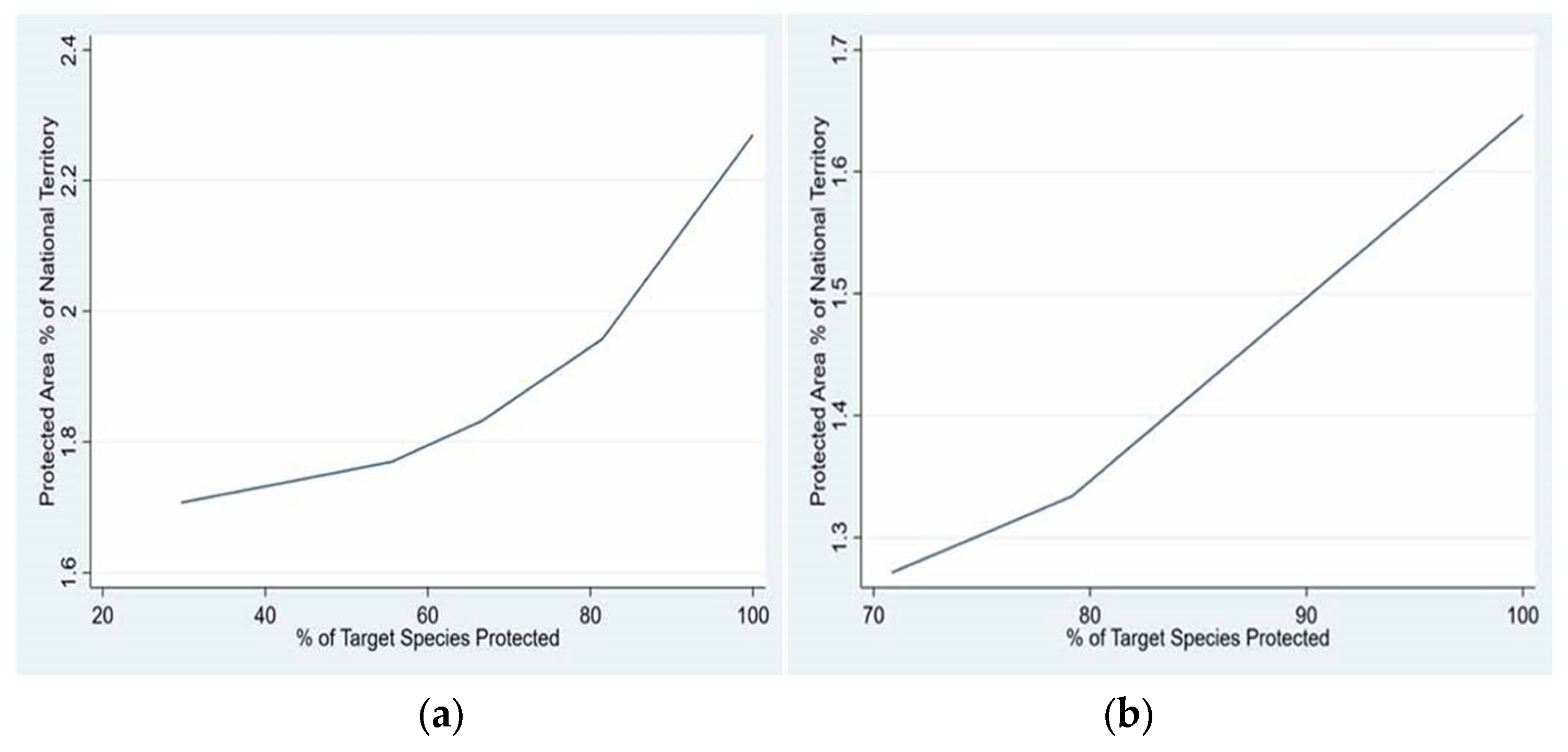
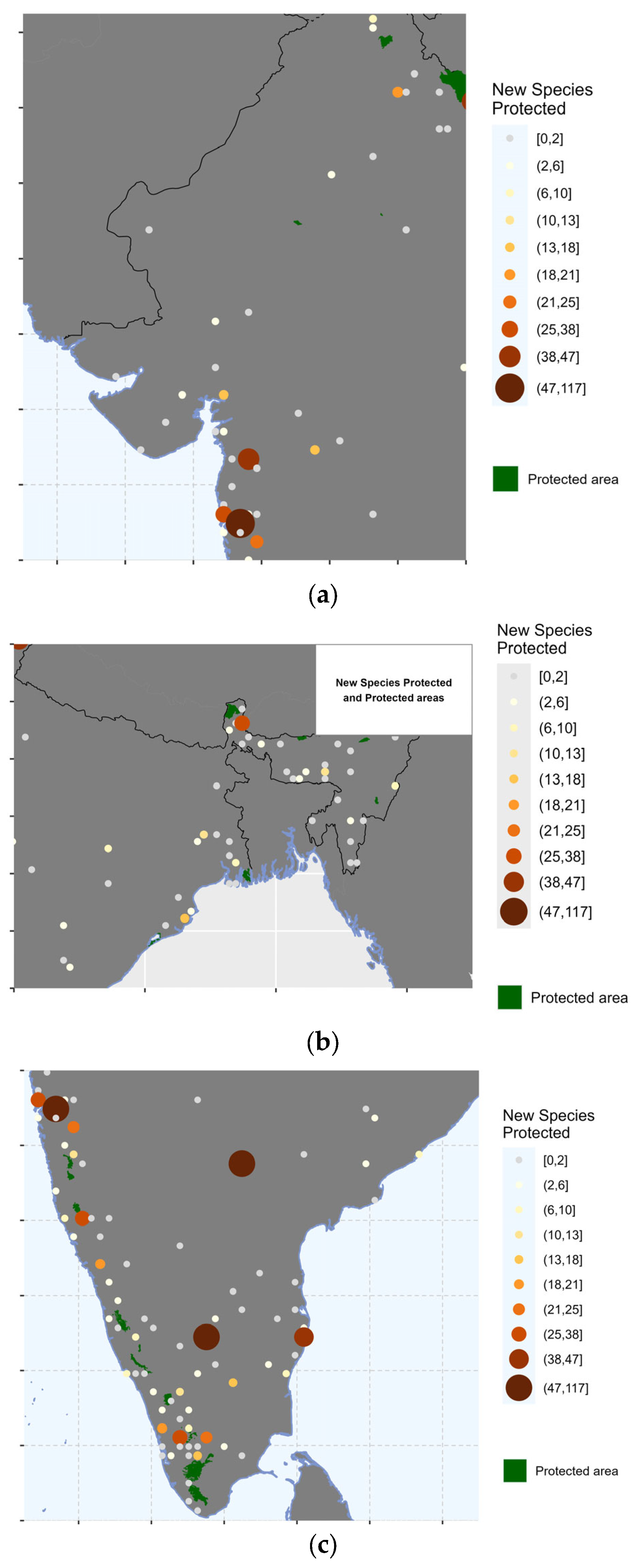

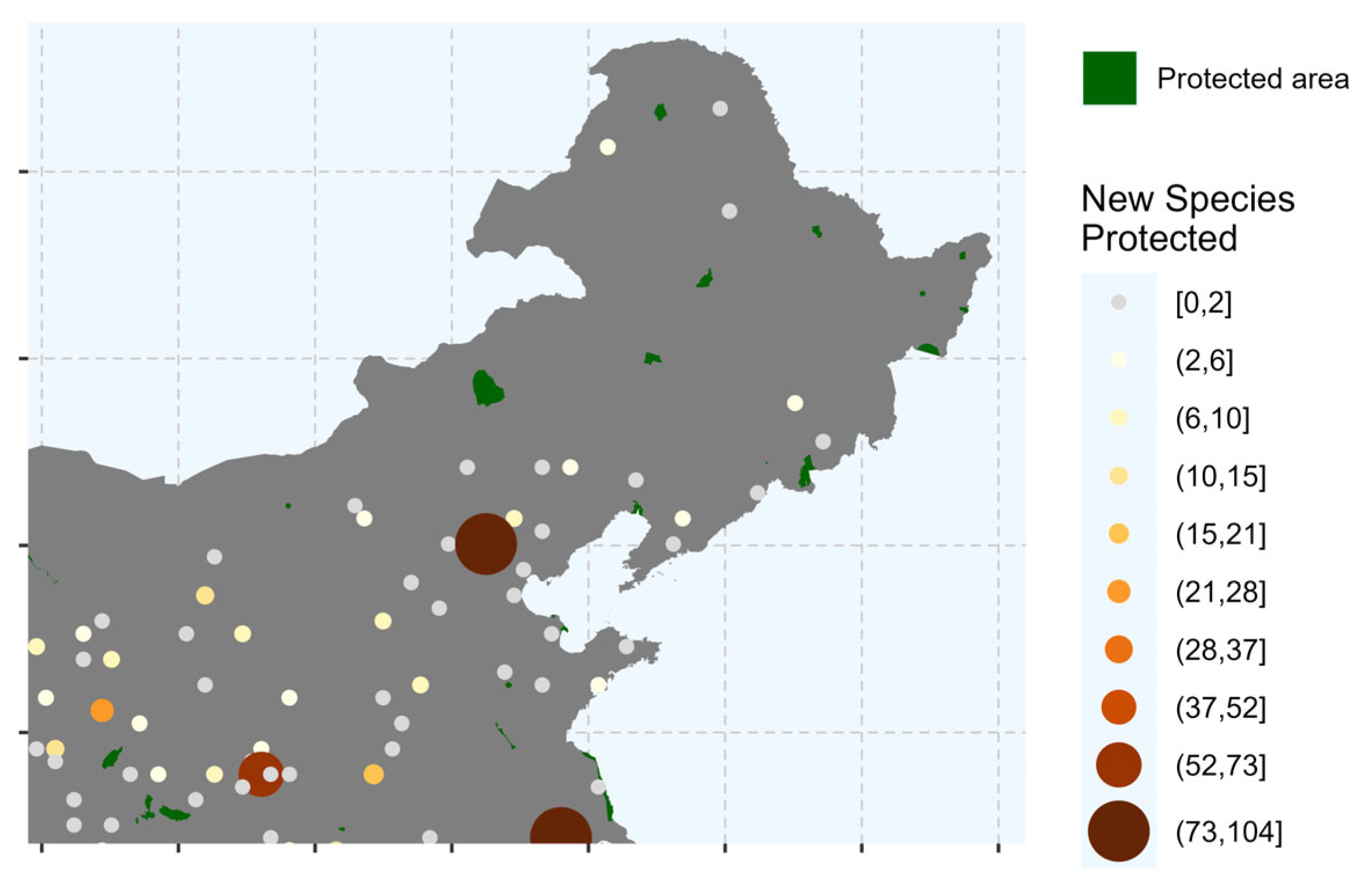
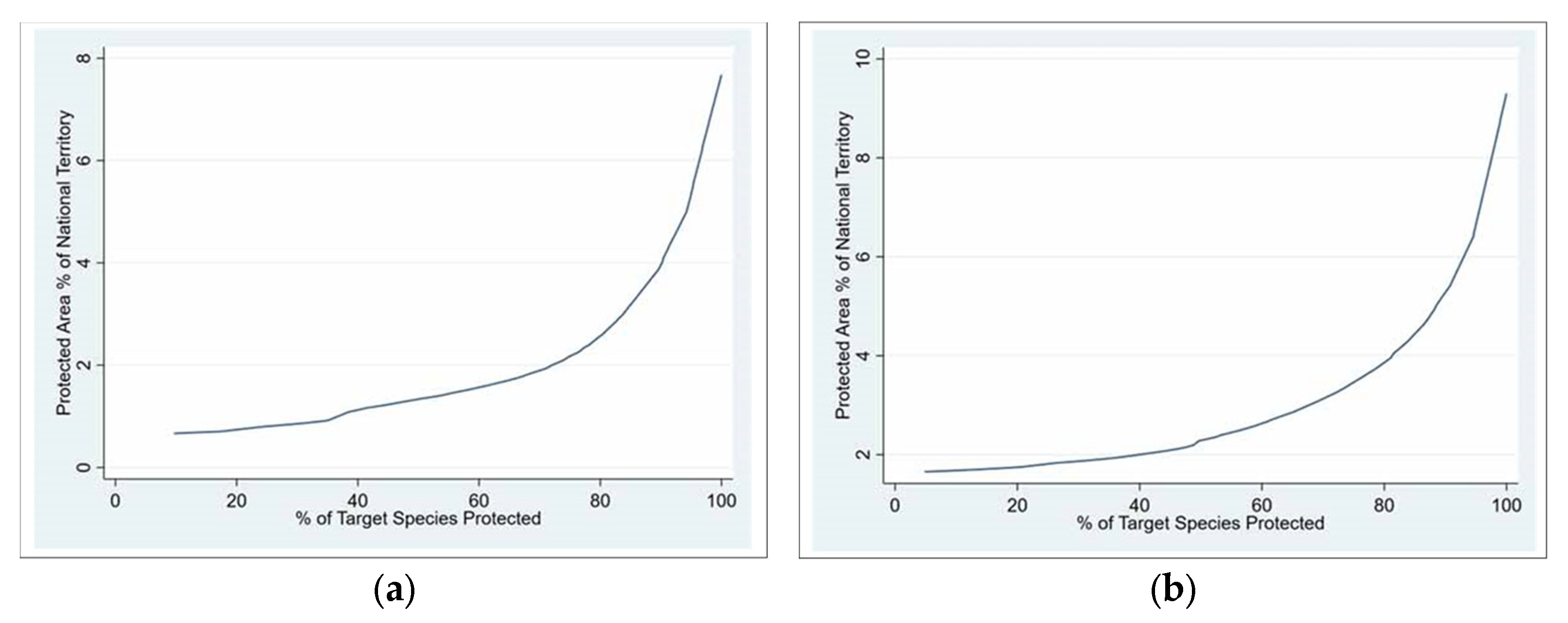
| Country | Arthropods | Fish | Fungi | Other Kingdoms | Mollusca | Terr. Vertebrates | Vascular Plants |
|---|---|---|---|---|---|---|---|
| Brazil | 3675 | 1253 | 418 | 123 | 740 | 928 | 13,713 |
| Cameroon | 192 | 45 | 7 | 0 | 8 | 60 | 320 |
| China | 3798 | 233 | 223 | 98 | 293 | 320 | 5098 |
| Costa Rica | 4288 | 28 | 163 | 4 | 189 | 74 | 981 |
| Ecuador | 712 | 95 | 42 | 11 | 138 | 302 | 2127 |
| India | 970 | 98 | 60 | 123 | 89 | 417 | 913 |
| Madagascar | 1448 | 37 | 9 | 2 | 771 | 668 | 5869 |
| Papua New Guinea | 617 | 63 | 102 | 1 | 251 | 251 | 2121 |
| Philippines | 438 | 120 | 0 | 2 | 649 | 579 | 447 |
| South Africa | 2398 | 200 | 118 | 72 | 712 | 194 | 9137 |
| Variable | Log Mean Protected-Area Size (sq km) |
|---|---|
| Log country area (sq km) | 0.614 *** 1 |
| (0.0397) 2 | |
| Constant | −2.587 *** 1 |
| (0.442) 2 | |
| Observations | 212 |
| R-squared | 0.533 |
| Priority Area (No.) | Species Total (%) | Plants Total (%) | Vertebrates Total (%) | Arthropods Total (%) | Other Species Total (%) |
|---|---|---|---|---|---|
| 1 | 62 (5.2%) | 7 (11.3%) | 6 (9.7%) | 39 (62.9%) | 10 (16.1%) |
| 2 | 55 (4.6%) | 38 (69.1%) | 0 (0.0%) | 17 (30.9%) | 0 (0.0%) |
| 3 | 47 (3.9%) | 1 (2.1%) | 0 (0.0%) | 46 (97.9%) | 0 (0.0%) |
| 4 | 40 (3.4%) | 38 (95.0%) | 0 (0.0%) | 2 (5.0%) | 0 (0.0%) |
| 5 | 39 (3.3%) | 20 (51.3%) | 2 (5.1%) | 0 (0.0%) | 17 (43.6%) |
| 6 | 31 (2.6%) | 30 (96.8%) | 0 (0.0%) | 1 (3.2%) | 0 (0.0%) |
| 7 | 30 (2.5%) | 27 (90.0%) | 1 (3.3%) | 1 (3.3%) | 1 (3.3%) |
| 8 | 27 (2.3%) | 18 (66.7%) | 5 (18.5%) | 4 (14.8%) | 0 (0.0%) |
| 9 | 26 (2.2%) | 24 (92.3%) | 1 (3.8%) | 1 (3.8%) | 0 (0.0%) |
| 10 | 25 (2.1%) | 3 (12.0%) | 1 (4.0%) | 19 (76.0%) | 2 (8.0%) |
| Priority Area (No.) | Species Total (%) | Plants Total (%) | Vertebrates Total (%) | Arthropods Total (%) | Other Species Total (%) |
|---|---|---|---|---|---|
| 1 | 73 (58.4%) | 0 (0.0%) | 0 (0.0%) | 73 (100.0%) | 0 (0.0%) |
| 2 | 8 (6.4%) | 0 (0.0%) | 0 (0.0%) | 8 (100.0%) | 0 (0.0%) |
| 3 | 5 (4.0%) | 0 (0.0%) | 0 (0.0%) | 0 (0.0%) | 5 (100.0%) |
| 4 | 4 (3.2%) | 0 (0.0%) | 0 (0.0%) | 4 (100.0%) | 0 (0.0%) |
| 5 | 3 (2.4%) | 2 (66.7%) | 0 (0.0%) | 0 (0.0%) | 1 (33.3%) |
| 6 | 3 (2.4%) | 0 (0.0%) | 1 (33.3%) | 1 (33.3%) | 1 (33.3%) |
| 7 | 3 (2.4%) | 0 (0.0%) | 0 (0.0%) | 3 (100.0%) | 0 (0.0%) |
| 8 | 2 (1.6%) | 1 (50.0%) | 0 (0.0%) | 0 (0.0%) | 1 (50.0%) |
| 9 | 2 (1.6%) | 0 (0.0%) | 0 (0.0%) | 0 (0.0%) | 2 (100.0%) |
| 10 | 2 (1.6%) | 0 (0.0%) | 0 (0.0%) | 2 (100.0%) | 0 (0.0%) |
Disclaimer/Publisher’s Note: The statements, opinions and data contained in all publications are solely those of the individual author(s) and contributor(s) and not of MDPI and/or the editor(s). MDPI and/or the editor(s) disclaim responsibility for any injury to people or property resulting from any ideas, methods, instructions or products referred to in the content. |
© 2025 by the authors. Licensee MDPI, Basel, Switzerland. This article is an open access article distributed under the terms and conditions of the Creative Commons Attribution (CC BY) license (https://creativecommons.org/licenses/by/4.0/) with the following mandatory and binding addition: Any and all disputes arising under this License that cannot be settled amicably shall be submitted to mediation in accordance with the WIPO Mediation Rules in effect at the time the work was published. If the request for mediation is not resolved within forty-five (45) days of the request, either You or the Licensor may, pursuant to a notice of arbitration communicated by reasonable means to the other party refer the dispute to final and binding arbitration to be conducted in accordance with UNCITRAL Arbitration Rules as then in force. The arbitral tribunal shall consist of a sole arbitrator and the language of the proceedings shall be English unless otherwise agreed. The place of arbitration shall be where the Licensor has its headquarters. The arbitral proceedings shall be conducted remotely (e.g., via telephone conference or written submissions) whenever practicable, or held at the World Bank headquarters in Washington DC.
Share and Cite
Dasgupta, S.; Wheeler, D.; Blankespoor, B. Pathways to 30 × 30: Evidence-Based Lessons from Global Case Studies in Biodiversity Conservation. Diversity 2025, 17, 401. https://doi.org/10.3390/d17060401
Dasgupta S, Wheeler D, Blankespoor B. Pathways to 30 × 30: Evidence-Based Lessons from Global Case Studies in Biodiversity Conservation. Diversity. 2025; 17(6):401. https://doi.org/10.3390/d17060401
Chicago/Turabian StyleDasgupta, Susmita, David Wheeler, and Brian Blankespoor. 2025. "Pathways to 30 × 30: Evidence-Based Lessons from Global Case Studies in Biodiversity Conservation" Diversity 17, no. 6: 401. https://doi.org/10.3390/d17060401
APA StyleDasgupta, S., Wheeler, D., & Blankespoor, B. (2025). Pathways to 30 × 30: Evidence-Based Lessons from Global Case Studies in Biodiversity Conservation. Diversity, 17(6), 401. https://doi.org/10.3390/d17060401









